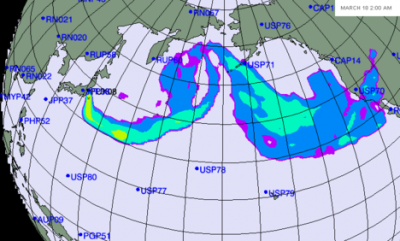Study: Dead Sea Creatures cover 98 percent of Ocean Floor off California coast; up from 1 percent before Fukushima

The Pacific Ocean appears to be dying, according to a new study recently published in the journal Proceedings of the National Academy of Sciences. Scientists from the Monterey Bay Aquarium Research Institute (MBARI) in California recently discovered that the number of dead sea creatures blanketing the floor of the Pacific is higher than it has ever been in the 24 years that monitoring has taken place, a phenomenon that the data suggests is a direct consequence of nuclear fallout from Fukushima.
Though the researchers involved with the work have been reluctant to pin Fukushima as a potential cause — National Geographic, which covered the study recently, did not even mention Fukushima — the timing of the discovery suggests that Fukushima is, perhaps, the cause. According to the data, this sudden explosion in so-called “sea snot,” which is the name given to the masses of dead sea creatures that sink to the ocean floor as food, has skyrocketed since the Fukushima incident occurred.
“In the 24 years of this study, the past two years have been the biggest amounts of this detritus by far,” stated Christine Huffard, a marine biologist at MBARI and leader of the study, to National Geographic.
At an ocean research station known as Station M, located 145 miles out to sea between the Californian cities of Santa Barbara and Monterey, Huffard and her colleague Ken Smith observed a sharp uptick in the amount of dead sea life drifting to the ocean floor. The masses of dead sea plankton, jellyfish, feces and other oceanic matter that typically only cover about 1 percent of the ocean floor were found to now be covering about 98 percent of it — and multiple other stations located throughout the Pacific have since reported similar figures.
“In March 2012, less than one percent of the seafloor beneath Station M was covered in dead sea salps,” writes Carrie Arnold for National Geographic. “By July 1, more than 98 percent of it was covered in the decomposing organisms. … The major increase in activity of deep-sea life in 2011 and 2012 weren’t limit to Station M, though: Other ocean-research stations reported similar data.”
No more sea life means no more oxygen in our atmosphere
Interestingly, Arnold does not even make a peep about Fukushima, which by all common sense is the most reasonable explanation for this sudden increase in dead sea life. Though the most significant increases were observed roughly a year after the incident, the study makes mention of the fact that the problems first began in 2011.
“Forget looking at global warming as the culprit,” writes National Geographic commenter “Grammy,” pointing out the lunacy of Arnold’s implication that the now-debunked global warming myth was the sudden cause of a 9,700 percent increase in dead sea life.
Backing her up, another National Geographic commenter jokingly stated that somehow “the earth took such a huge hit in a four-month timeframe of a meltdown via global warming and we as a people didn’t recognize this while [it was] happening; while coincidentally during that same time frame the event at Fukushima took place.”
It is almost as if the powers that be want us all to forget about Fukushima and the catastrophic damage it continues to cause to our planet. But they will not be able to cover up the truth forever, as human life is dependent upon healthy oceans, the life of which provides the oxygen that we all need to breathe and survive.
Sources for this article include:
http://newswatch.nationalgeographic.com
http://science.naturalnews.com
http://science.naturalnews.com
http://science.naturalnews.com

